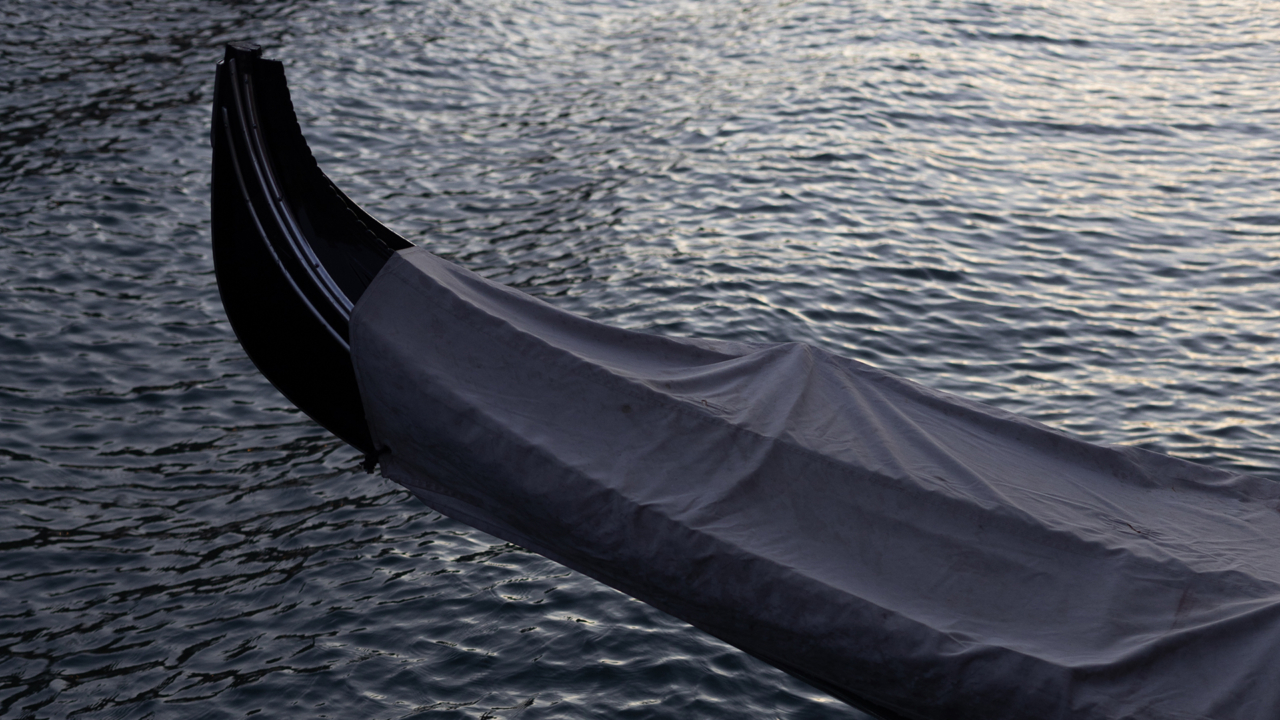

Photograph by Camilla Glorioso / Connected Archives
WORDS BY CHRIS IOVENKO
The mayor of Venice renews the city’s marital vows every spring. In a tradition that began around the year 1000, he leads a fleet of vessels to San Nicolò church where he meets Venice’s eternal partner: the Adriatic Sea.
“I wed thee, O Sea, in token of true and lasting dominion,” the mayor recites as he tosses a ring into the water. The symbolic act of marriage between city and sea is blessed by the Patriarch of Venice, a partnership over a thousand years old. But like many long marriages, that relationship has become complicated by time and change.
Venice, a UNESCO World Heritage Site built on 128 islands in a lagoon, is slowly sinking under the rising seawater that surrounds it. Historically, the city has been plagued by encroaching waters. Since 2020, a system of floodgates has protected it from storm surges and high tides. However, as climate change raises sea levels higher and higher, some fear the interim fix may eventually falter.
“Seawalls are not a panacea,” said John Englander, oceanographer, author, and President of the Rising Seas Institute. “We will inevitably continue to try them in some places but we need to realize that they’re a temporary solution. Nobody knows for sure but they may buy us 20, 30, or 40 years, but when their design height is exceeded, we’ll be worse off than before.”
Officially called the Experimental Electromechanical Model, but colloquially known as the MOSE barrier (a tip of the Gondolier’s hat to Moses, the Biblical divider of the Red Sea), Venice’s flood protection system is a series of some 78 submerged gates and barriers that can be raised to seal off the Venice lagoon from the Adriatic. These barriers now protect the old city from the high tides that used to pose existential threats.
Venice is bound to the sea that surrounds it; in fact, its aqueous environment was the reason it was settled in the first place. In the fifth century, refugees from the collapsing Roman Empire fled foreign invaders and found refuge in Venice, at that time little more than a collection of fishing villages. The lagoon that embraced Venice acted like a moat and rendered the city impregnable for most of its storied history.
In addition to security, the lagoon and the Adriatic Sea beyond became the primary source of employment and wealth for the community. Fishing was important for sustenance and revenue, but soon, the true value of water asserted itself as Venice founded a trading empire based on its militarized waterborne fleet. By the Middle Ages, Venice had become a rich and powerful city-state, one that rivaled its much larger European counterparts.
Although Venice has always been subjected to flooding, the situation became increasingly dire as the 20th century progressed. The accelerating severity of the problem became apparent to all in 1966 when an anomalous (for the time) storm surge also known as the “Great Flood of Venice” inundated 80% of the city.
Venice may not be able to act as a model for other cities, but as waters creep inland, plans for protecting our cities from flooding through coastal engineering will become increasingly urgent.
In response to the crisis, Italy rewrote its laws in 1972 in an effort to protect Venice for posterity. The physical solution to Venice’s flooding problems, which eventually emerged as MOSE, took decades to construct. President Silvio Berlusconi, a booster of the project, inaugurated MOSE in 2003 with the predicted opening slated for 2010.
Unfortunately, the project became a magnet for corruption; in 2014, the then-mayor of Venice Giorgio Orsoni, and some 24 city council members were arrested on corruption charges and forced to resign. Not surprisingly, construction was delayed, and the price of the project ballooned. MOSE gained a reputation as a boondoggle, and critics declared the still-unfinished project an epic failure that might need to be halted and dismantled.
Then, in November 2019, heavy rains combined with very high tides of 6.1 feet flooded 80% of the city. It was the worst high-water event in 50 years, which resulted in two deaths and caused hundreds of millions of dollars in property damage. Less than a year later, MOSE was finally completed for a cost of $6.2 billion, more than triple the original estimate. On October 3rd, 2020 when a high tide of 4.4 feet was forecasted, MOSE was activated for the first time. Usually, a tide of that height would submerge half the city, but with the MOSE barriers raised Venice stayed miraculously dry.
Concerns do remain about MOSE’s impacts on the lagoon’s fragile ecosystems. Fabio Pranovi, professor of Environmental Sciences at the Ca’ Foscari University of Venice, pointed out that MOSE blocks influx during the highest tides when historically, the entirety of the lagoon’s water would be cycled out for fresh seawater. Without this exchange, Pranovi said that marine sediment and organic matter will build up and potentially impact the lagoon’s delicate ecosystems.
“MOSE is a good example of how to solve the issue of flooding from an engineering perspective,” said Pranovi. “From an environmental or holistic perspective, it is the wrong solution because it risks introducing negative effects into the entire lagoon.”
But the skepticism and scandal that clouded the public perception of MOSE largely dissipated. The system quickly proved its worth, and critics were largely silenced.
The question of whether Venice’s solution to keeping rising waters out could work elsewhere is an open one. MOSE is a specific design based on Venice’s rather unique lagoon location. Although it’s a big aesthetic improvement over having enormous floodgates positioned on dry land, putting the gates underwater was an unusual approach given the corrosive effects of seawater as well as the costly build-up of sediment and sea life on the metal structures.
“It was designed to be invisible when not closed but having all the hinges in the water is kind of a weird solution in many ways,” said Fabio Carrera. “But you know, it works.”
Carrera said that this unusual configuration may limit the appeal of MOSE-style sea gates to other cities that are looking at flood-prevention infrastructure projects. As it is, every time the barriers are raised requires a multitude of workers and costs about $300,000. This high cost of operation might also deter other cities from copying MOSE, even if the coastal geography happened to be very similar.
“We’ve got to make sure we don’t keep making things worse, so we need to come at it from both ends, reducing emissions and adaptation.”
Venice is not the first city to have built massive floodgates to keep low-lying areas dry. Following a North Sea storm surge in 1953 that killed 307 people in England, London spent nearly 30 years building the Thames Barrier. It’s a marvel of engineering with 10 enormous floodgates that can hold back 90,000 tons of water. It has been used over 100 times to prevent London from flooding, and due to climate change, the number of times it’s used each year has risen dramatically.
However, both MOSE and the Thames Barrier were not designed to meet the challenges of rapid climate change and the attendant rise in sea level. Both can only hold back so much water, and at some point in the not-too-distant future, they will become obsolete.
For cities debating similar structures now, that may happen before they’re even deployed. Each one takes decades to build. If they’re outpaced by climate change, the hundreds of millions of dollars that they cost will have been all but tossed into the sea. A case in point is the $14 billion system of floodwalls and levees built to protect New Orleans following Hurricane Katrina in 2005. It was one of the largest construction projects ever undertaken by the U.S. Army Corps of Engineers and was completed in 2019. However, the Corps of Engineers now warns that the system may already be inadequate due to land subsidence and sea level rise.
Although Venice is unique historically and architecturally in many ways, the issue of protecting coastal cities from rising seas and storm surges in the age of sea level rise has become universal due to climate change. The ocean has absorbed 90% of Earth’s excess heat, and 2023 was by far the warmest year on record for both terrestrial and ocean temperatures. Oceans are warming much faster in the Arctic which holds 90% of Earth’s ice—if melted, this would result in 200 feet of sea level rise. In 2023 the Arctic recorded its lowest level of sea ice on record, baffling scientists since these conditions were not supposed to be reached until we hit 3°C of global warming.
“The world is warming faster and faster,” said Englander. “It appears that there were feedback loops and the projections for sea level rise are being exceeded. There are just obviously parts of the physics of the planet we don’t fully understand.”
How quickly and how high sea levels will rise is hotly debated, but scientists agree that the deep oceans will warm and the seas will rise for at least a millennium. Venice may not be able to act as a model for other cities, but as waters creep inland, plans for protecting our cities from flooding through coastal engineering will become increasingly urgent. However, walls and barriers are not a silver bullet; it remains crucial to address the fundamental problem of carbon emissions that are driving sea level rise.
“We’ve got to make sure we don’t keep making things worse, so we need to come at it from both ends,” said Shana Udvardy, the Senior Climate Resilience Policy Analyst at the Union of Concerned Scientists, “reducing emissions and adaptation.”
Science Saved Venice From Drowning. Could It Work Anywhere Else?